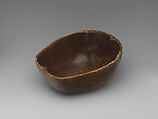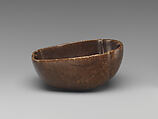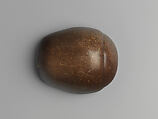On loan to The Met The Met accepts temporary loans of art both for short-term exhibitions and for long-term display in its galleries.
Skull Cup (kapala)
Not on view
In Vajrayana Buddhism, the upper cranium of the human skull (kapala) is used for tantric alchemy in which the impurities of mundane passions—namely, the three poisons of ignorance, greed, and delusion—are exorcised and thereby transformed into forces for good, wisdom, and compassion. It is perhaps the highest expression of the comprehension of the transient nature of the human body and thus of bodily detachment, a necessary step on the path to achieving the clarity of "Diamond Vehicle" (Vajrayana) enlightenment. The kapala is employed by virtually all the wrathful deities and is shown brimming with the brain and other sense organs, which must be cut away by the flaying knife to reveal true clarity of mind. In Tibetan paintings, such as the fifteenth-century murals at Gyanste monastery, the Mahasiddhas, the perfected Indian tantric yogis much revered in Tibet, are often depicted drinking from skull cups—a practice in keeping with the use of the kapala by Hindu deities, most notably Shiva Bhairava.
This image cannot be enlarged, viewed at full screen, or downloaded.
This artwork is meant to be viewed from right to left. Scroll left to view more.






